CLASS-10 CHAPTER-10 LIGHT:REFLECTION AND REFRACTION
LIGHT
Light is a form of energy that enable us to see the objects. We are able to see the objects when a ray of light reflected from that object strike to retina of our eyes.
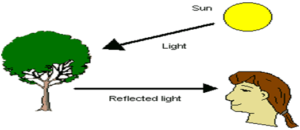
NATURE OF LIGHT
The nature of light can be explained on the basis of the following theories
(a)Newton’s Cropuscular Theory
(b) Huygen’s Theory
(c)Modern Theory
(a) NEWTON’S CROPUSCULAR THEORY
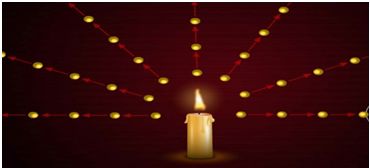
Particle nature of light
According to professor Isaac Newton’s Corpuscular Theory, light is made up of tiny particles. When these particles strike to our retina then we see the objects.
On the basis of Newton’s Corpuscular Theory , some of the phenomenon of light couldn’t be explained due to which this theory become failed.
(b) HUYGEN’S THEORY
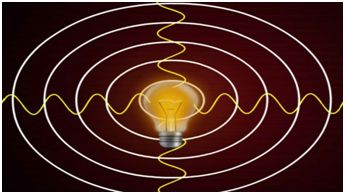
Wave nature of light
According to professor Huygen, light is made up of waves when these waves strike to our retina then we see the objects.
On the basis of Huygen’s theory , some of the phenomenon of light couldn’t be explained due to which this theory become failed.
(c) MODERN THEORY/QUANTUM NATURE/DUAL NATURE OF LIGHT
According to Modern theory of light, light is neither completely a wave nor a particle. That is why, we call it dual nature of light.
SOME IMPORTANT TERMS RELATED TO LIGHT
1. SOURCE OF LIGHT
A source of light is an object from which light is given out. Some sources of light are natural like sun while other are artificial like tube light, bulb, candle etc.
The sources of light are mainly divided into two categories
(a)Self-Luminous
(b)Non-Luminous
(a)SELF-LUMINOUS-A self-luminous source is that which has light of its own eg- Sun, Stars, Lamps etc.
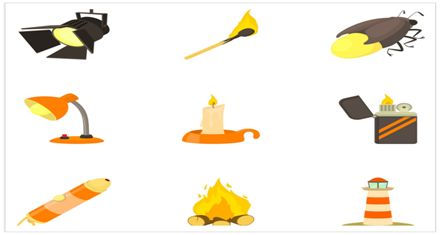
Self-Luminous Objects
(b)NON-LUMINOUS-A Non-luminous source is that which does not has light of its own. It receive light from external source and scatters it. Eg- Table, chair, book moon etc.
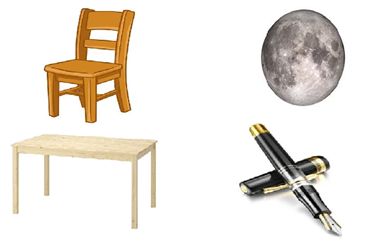
Non-Luminous Objects
2. MEDIUM OF LIGHT
A medium is a substance through which light passes or tries to do so. There are three types of medium of light.
(a) Transparent medium
(b) Translucent medium
(c) Opaque Medium

(a)TRANSPARENT MEDIUM-It is a medium through which light passes completely. Eg- Air, Water, glass etc.
(b)TRANSLUCENT MEDIUM- It is a medium through which light passes partially. Eg-Paper, canopy etc.
(c)OPAQUE MEDIUM- It is a medium through which light can never pass. Eg- wood, plastic, metals etc.
3.RAY OF LIGHT
A ray of light is the straight line path along which light travels.

4.BEAM OF LIGHT
A number of rays combine together to form a beam of light.

TYPES OF BEAMS
There are three types of beam of light.
(a)Parallel Beam
(b) Convergent Beam
(c) Divergent Beam
(a)PARALLEL BEAM OF LIGHT- It is a beam of light in which rays of light move parallel to each other. The width of parallel beam remain constant.

(b) DIVERGENT BEAM OF LIGHT-It is a beam of light in which rays of light given out from a point source. The width of a convergent beam increases along with propagation.

(c)CONVERGENT BEAM OF LIGHT- It is a beam of light in which rays of light converge (meet) at a point. The width of a convergent beam decreases along with propagation.

REFLECTION OF LIGHT
Bouncing back of light in the same medium after striking to reflecting surface is called reflection of light.
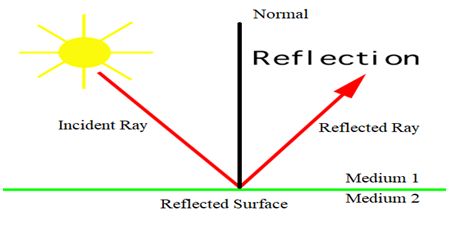
Reflection of light
- NORMAL- Perpendicular drawn on reflecting surface at the point of incident is called normal.
- ANGLE OF INCIDENCE-The angle between normal and incident ray is called angle of incidence. It is denoted by symbol ‘I’.
- ANGLE OF REFLECTION- The angle between normal and reflected ray is called angle of reflection. It is denoted by symbol ‘r’.
- INCIDENT RAY-A ray of light striking on reflecting surface is called ray of incidence or incident ray
- REFLECTED RAY- The ray of light which bounce back after reflection is called ray of reflection or reflected ray.
TYPES OF REFLECTION
There are two types of reflection.
- Regular Reflection
- Irregular reflection or Diffused reflection
1.REGULAR REFLECTION
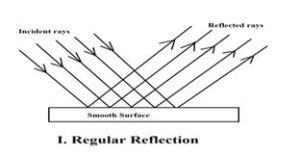
When parallel rays of light fall on a smooth and well polished surface then they reflect back parallel to one another. Such a reflection is called regular reflection.
2.IRREGULAR REFLECTION
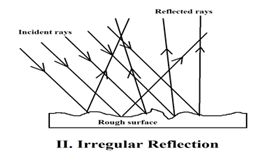
When a parallel rays of light fall on a rough(irregular) surface then they reflect in different directions. Such a reflection is called irregular of diffused reflection.
LAWS OF REFLECTION
There are two laws of reflection
- The angle of incidence is always equal to the angle of reflection. i.e <i=<r.
- The incident ray, reflected ray and normal all lie in the same plane at the point of incidence.
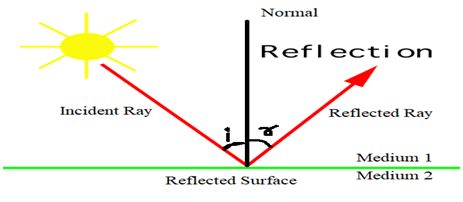
REAL AND VIRTUAL IMAGES
1.REAL IMAGE- The image that can be obtained on a screen is called real image. A real image is formed when rays of light actually meet after reflection. Eg-Images formed in a cinema hall are a real image.
2.VIRTUAL IMAGE- The image that can not be obtained on a screen is called virtual image. Virtual image is formed when rays of light virtually meet after reflection. Eg- Image formed by a plane mirror is a virtual image.
DIFFERENCES BETWEEN REAL AND VIRTUAL IMAGES
REAL IMAGE | VIRTUAL IMAGE |
1.It can be obtained on a screen. | 1.It can not be obtained on a screen. |
2. It is formed when rays of light actually meet after reflection. | 2. It is formed when rays of light virtually meet after reflection. |
3.Real images are always inverted | 3.Virtual images are always erect |
4. A real image always formed in front of the mirror. | 4. A virtual image always formed behind the mirror. |
5. A real image always formed behind the lens. | 5. A virtual image always formed in front of the lens. |
MIRROR
A smooth well polished surface is from which reflection of light takes place is called mirror. Mirrors can be classified as plane mirror and spherical mirror.
- PLANE MIRROR-The mirror which has a plane reflecting surface is called plane mirror.
- SPHERICAL MIRROR-The mirror which has spherical reflecting surface is called spherical mirror. There are two types of spherical mirrors.
(a) Concave mirror
(b) Convex mirror

(a) CONCAVE MIRROR-The spherical mirror whose reflecting surface is curved inward is called concave mirror.
(b)CONVEX MIRROR-The spherical mirror whose reflecting surface is curved outward is called convex mirror.
SOME OTHER TERMS RELATED TO SPHERICAL MIRRORS

1. CENTRE OF CURVATURE(C)–Center of curvature of a spherical mirror is the centre of the hollow sphere of glass from which spherical mirror is cut. It is denoted by symbol ‘C’.
2. RADIUS OF CURVATURE(R)- Radius of curvature of a spherical mirror is the radius of a hollow sphere of glass from which spherical mirror is cut. It is denoted by symbol ‘R’.
OR
Radius of curvature is the distance between the pole and the centre of curvature.
3.POLE-The pole of a spherical mirror is the centre of the mirror. It is represented by symbol ‘P’.
4.PRINCIPAL AXIS- The principal axis of a spherical mirror is an imaginary line passing through centre of curvature(C) and pole(P) and can be produced on both sides . It is represented by XX’.
5.APERTURE-The aperture of a mirror is the diameter of reflecting surface of the mirror. It is represented by MM’.
6.PRINCIPAL FOCUS
(a)FOR CONCAVE MIRROR- Rays of light parallel to principal axis after reflection from a concave mirror converge(meet) at a point in front of the mirror. This point is called principal focus of the concave mirror.
(b)FOR CONVEX MIRROR- Rays of light parallel to principal axis after reflection from a convex mirror get diverge and appear to come from a point behind the mirror. This point is known as the principal focus of the convex mirror.
7.FOCAL LENGTH- The distance between the principal focus and pole of a mirror is called its focal length. It is represented by ‘f’.
RELATIONSHIP BETWEEN RADIUS OF CURVATURE AND FOCAL LENGTH
The focal length of a spherical mirror is always half of its radius of curvature.
Focal length= (Radius of curvature)/2
Or
f= R/2
CHARACTERISTICS OF IMAGE FORMED BY PLANE MIRROR

- Image formed by a plane mirror is always virtual which can not be obtained on screen.
- Image formed by a plane mirror is always erect.
- The size of image is always equal to the size of object.
- The image formed by a plane mirror is laterally inverted. It means left side of object become right and right side become left.
- The image is formed at the same distance from the mirror a object
RULES FOR IMAGE FORMATION BY CONCAVE MIRROR
RULE 1-When a ray of light incident parallel to principal axis then after reflection it always passes through focus.

RULE 2-When a ray of light incident through focus then after reflection it always goes parallel to principal axis.

RULE 3-When a ray of light incident through centre of curvature then after reflection it always reflect back on its own path.

RULE 4-When a ray of light incident at pole then it reflect with same angle as per law of reflection. i.e <i=<r.
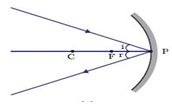
IMAGES FORMED BY CONCAVE MIRROR
1. When object is placed at infinity.

Position: At focus
Nature: Real and Inverted
Size: Highly Diminished
2. When Object is placed at C but at a finite distance.

Position: Between C and F
Nature: Real and Inverted
Size: Diminished
3. When Object is placed at C.

Position: At C
Nature: Real and Inverted
Size: Same size as Object
4.When Object is placed between C and F.
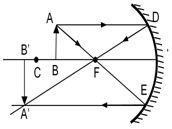
Position: Beyond C
Nature: Real and Inverted
Size: Enlarged
5. When Object is placed at F.
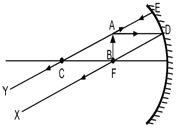
Position: At Infinity
Nature: Real and Inverted
Size: Highly Enlarged
6. When Object is placed between F and P.

Position: Behind the mirror
Nature: Virtual and Erect
Size: Enlarged
RULES FOR IMAGE FORMATION BY CONVEX MIRROR
RULE 1. Rays of light parallel to principal axis after reflection get diverge and appear to come from a point behind the mirror known as focus.
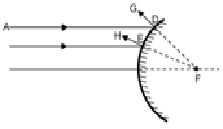
RULE 2. Rays of light coming towards the focus after reflection goes parallel to principal axis.
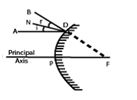
RULE 3. Rays of light coming towards the centre of curvature(C) after reflection return back on their own path.

RULE 4. Rays of light incident at the pole of the mirror reflect back by making same angle with normal as angle of incidence.

IMAGE FORMATION BY A CONVEX MIRROR
1.When object is placed at infinity.

Position: At Focus
Nature: Virtual and Erect
Size: Highly Diminished
2.When object is placed in front of mirror but at a finite distance.
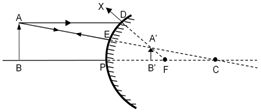
Position: Behind the mirror (between P & F)
Nature: Virtual and Erect
Size: Diminished
MIRROR FORMULA
Mirror formula represent a relationship among focal length(f) ,Object distance(u) and Image distance (v)

Where u – Object Distance
v-Image Distance
f-Focal Length
MAGNIFICATION OF MIRRORS
Magnification of mirror can be defined as the ratio of the height of image to the height of object.
magnification= height of image/height of object
m= hi/ ho
Magnification of mirror can also be expressed in terms of image distance and object distance.
m=-v/u
=> m= hi/ho = -v/u
Note- Magnification has no unit because it is a ratio.
Note- Different conditions for Magnification.
- If |m|>1, Image is enlarged.
- If |m|<1, Image is diminished.
- If |m|=1, Image is of same size as object.
- If m=+ ive, Image is virtual and erect.
- If m=-ive, Image is virtual and inverted.
Note-Focal length of a convex mirror is always taken as +ive and the focal length of a concave mirror is always taken as negative.
SIGN CONVENTION FOR A SPHERICAL MIRROR
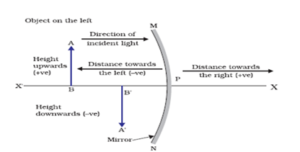
- Principal axis is always taken along X-axis.
- Object is always placed on the left side of the mirror.
- All the distances (Object distance and Image distance) are measured from pole.
- All the distances measured towards left to the mirror are taken as negative.
- All the distances measured towards right to the mirror are taken as positive.
- All the distances perpendicularly downwards to principal axis are taken as negative.
- All the distances perpendicularly upwards to principal axis are taken as positive.
USES OF SPHERICAL MIRROR
1. USES OF CONCAVE MIRROR
(i) Concave mirrors are used in torches, search lights, vehicle’s headlights to get a powerful beam of light.
(ii) Concave mirrors are used as saving mirror to get larger image of face.
(iii) Dentists use concave mirror to get larger image of teeth.
(iv) Large concave mirrors are used to concentrate sunlight in solar furnace.
2. USES OF CONVEX MIRROR
(i) Convex mirrors are used as rear view mirror in vehicles because they always give an erect image and have a wider field of view.
(ii) Big convex mirrors are used as security mirrors in shops.
(iii) Convex mirrors are used on U-turns on the roads to see the vehicles coming from other side
REFRACTION OF LIGHT
When a ray of light travels from one transparent medium to another, it get bent towards or away the normal. This phenomenon is known as Refraction of light.
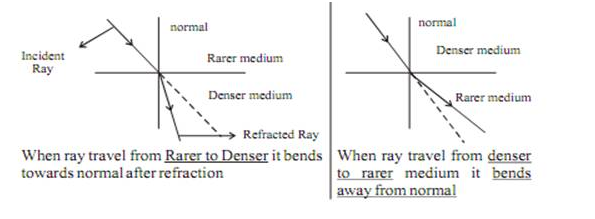
1. When a ray of light travels from a rarer medium to denser medium then it bends towards the normal.
2. When a ray of light travels from a denser medium to rarer medium then it bends away the normal.
RARER AND DENSER MEDIUM
1.The medium in which speed of light is more and have lower density is called optically rarer medium.
2. The medium in which speed of light is less and have higher density is called optically denser medium.
LAWS OF REFRACTION
There are two laws of refraction.

LAW 1: The incident ray, refracted ray and normal all lie in same plane at the point of incident.
LAW 2: The ratio of sine of angle of incident to the sine of angle of refraction is constant for a light of given colour and a given pair of media. This law is also known as snell’s law of refraction.
i.e Sine i / Sine r = Constant(n)
REFRACTIVE INDEX OR ABSOLUTE REFRACTIVE INDEX
The absolute refractive index of a medium is the ratio of the speed of light in air to the speed of light in that medium.
Absolute refractive index(n)= Speed of light in Air/ Speed of light in medium
n=c/v
RELATIVE REFRACTIVE INDEX
The relative refractive index of medium 2 with respect to medium 1 is the ratio of the speed of light in medium 1 to the speed of light in medium 2.
Relative refractive index(n21)= Speed of light in medium 1 /Speed of light in medium 2
n21= V1/V2
Note- Relative refractive index of medium 2 with respect to medium 1 is the ratio of the refractive index of medium 1 to the refractive index of medium 2.
n21= n2/n1
Note- Refractive index has no unit because it is a ratio.
REFRACTION OF LIGHT THROUGH RECTANGULAR GLASS PRISM
When a ray of light passes through a glass slab then it gets bent twice at air-glass interface and glass-air interface.
The emergent ray is always goes parallel to the incident ray with a Lateral displacement d.
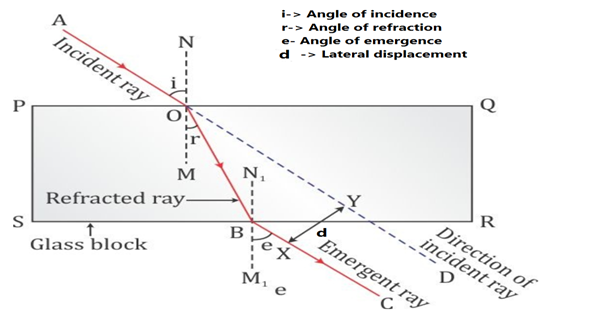
SPHERICAL LENSES
A spherical lens is a transparent material bounded by two surfaces in which one or both may be curved. There are two types of spherical lenses.
- Convex lens
- Concave lens
 1. CONVEX LENS–It is a spherical lens which is thicker at middle and thinner at edges.
1. CONVEX LENS–It is a spherical lens which is thicker at middle and thinner at edges.
A ray of light parallel to principal axis after refraction from a convex lens converges at a point on principal axis known Focus. There for they are known as convergent lens.
2. CONCAVE LENS-It is a spherical lens which is thinner at middle and thicker at edges.
A ray of light parallel to principal axis after refraction from a concave lens get diverge and appear to come from a point on principal axis behind the mirror known Focus. There for they are known as divergent lens.
SOME OTHER TERMS RELATED TO SPHERICAL LENSES
1.CENTRE OF CURVATURE- It is the center of the imaginary sphere from which spherical lens is cut.
2.RADIUS OF CURVATURE- It is the radius of the imaginary sphere from which the lens is cut. It is denoted by ‘R’.
3.OPTICAL CENTRE- The centre point of the lens is called optical centre. It is denoted by ‘O’.
4. PRINCIPAL AXIS- The line joining the optical centre and centre of curvature is called principal axis.
5. PRINCIPAL FOCUS
(i) In convex lenses, the rays of light parallel to principal axis after refraction converge at a point known as principal focus of the lens.
(ii) In concave lens, the rays of light parallel to principal axis after refraction get diverged and appear to come from a point on the same side of the lens known as principal focus of the lens.
LENS FORMULA
Lens formula represent a relationship among focal length(f) ,Object distance(u) and Image distance (v)

Where u – Object Distance
v-Image Distance
f-Focal Length
MAGNIFICATION OF MIRRORS
Magnification of lenses can be defined as the ratio of the height of image to the height of object.

Magnification of lenses can also be expressed in terms of image distance and object distance.
m= v/u
==> m = hi /ho
RULES FOR IMAGE FORMATION BY CONVEX LENS
RULE 1.
1. A ray of light parallel to principal axis after refraction through convex a lens passes through Principal Focus.
2.A ray of light parallel to principal axis after refraction through a concave lens gets diverge and appear to came from principal Focus.

RULE 2.
1.A ray of light incident through focus(F1) after refraction through a convex lens goes parallel to principal axis.
2.A ray of light incident toward focus after refraction through a concave lens goes parallel to principal axis.

RULE 3.
1.A ray of light incident through optical centre after refraction through a convex lens goes straight without any deviation.
2.A ray of light incident through optical centre after refraction through a convex lens goes straight without any deviation.

IMAGE FORMATION BY A CONVEX LENS
1.When object is placed at infinity.

Position: At Focus
Nature: Real and inverted
Size: Highly Diminished
2.When object is placed beyond 2F1 but at a finite distance.

Position: Between F and 2F
Nature: Real and inverted
Size: Diminished
3. When object is placed at 2F1

Position: At 2F
Nature: Real and inverted
Size: Same size as object.
4.When object is placed between 2F1 and F1.

Position: Beyond 2F
Nature: Real and inverted
Size: Enlarged
5. When object is placed at F1

Position: At infinity
Nature: Real and inverted
Size: Highly Enlarged
6.When object is placed between O and F1.

Position: In front of the lens
Nature: Virtual and erect
Size: Enlarged.
IMAGE FORMATION BY A CONCAVE LENS
1. When object is placed at infinity

Position: At Focus in front of lens
Nature: Virtual and erect
Size: Highly diminished
2.When object is placed between infinity and optical centre.

Position: Between Optical centre and Focus
Nature: Virtual and erect
Size: Diminished
FOCAL LENGTH OF COMBINATION OF TWO OR MORE LENSES
Lets two lenses of focal lengths f1 and f2 are combined together, If their combine focal length is f then,

POWER OF A LENS
The reciprocal of focal length of a lens is known as power of the lens. It is denoted by P. Its SI unit is Dioptre (D).
